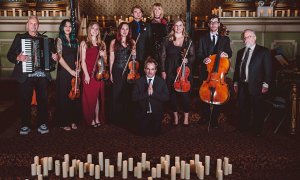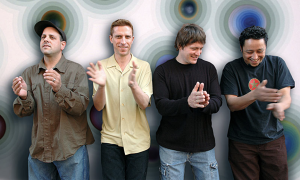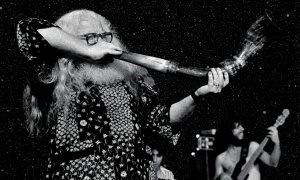Home » Jazz Articles » From the Inside Out » Groovin’ Hard In Every Style
Groovin’ Hard In Every Style
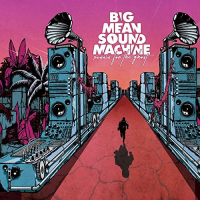 Big Mean Sound Machine
Big Mean Sound MachineRunnin' for the Ghost
Peace & Rhythm | Blank Slate Records
2017
On Runnin' for the Ghost, Big Mean Sound Machine sounds intent on obliterating every imaginable musical border: the lines between regional or geographic styles, the divide between acoustic and electronic instruments, the boundary between live and sampled music, the gap between ancient and contemporary music...just about any and every musical "box" you can think of.
The fourth full-length chapter in the musical story of this ten-piece afrobeat band led by bassist Angelo Peters was inspired by performing with master afrobeat drummer Tony Allen; their liner notes reveal that, "This album is dedicated to the sharing of music and education."
Runnin' for the Ghost continually grows in density, color and dynamics, and feels like you've jammed your ears into the high-speed spin cycle of an afrobeat washing machine. "Seeing the Bigger Picture" synthesizes afrobeat guitar and melody with Afro-Cuban percussion patterns, convening near the Caribbean through Peters' hard-rocking bass line (as if meeting in their geographic middle), with a synthesizer solo wriggling through like a line scribbled in fluorescent color.
"Van Chatter," which blends Central African Soukous with West African Highlife, kicks off from Andrew Klein's drumrolls and just keeps right on rolling. Klein and other percussionists keep this pot boiling hot while guitarist Dan Barker spreads electric juju on top like sticky glittery jam, melting with the horns and the rhythm section into that curious musical place where rhythm and melody meet. As its title suggests, "Triple Bacon" stacks thick slices of meaty bass, drums, percussion and guitar into a multi-decked afrobeat and highlife sandwich, joyous and tasty.
The relentlessly undulating serpentine horn chart in the title track is remarkably arranged and even more expertly played. This tune comes out of the box sounding like it's already been (pre-)remixed by The Chemical Brothers—a computerized rhythm like the underbelly of a rampaging mechanical bull driving a Latin brass band's march through ancient Egyptian deserts, and ending with a birdsong's curtain call of solitary flute against harmonizing electronics. Simply remarkable.
Recorded live, with half captured in a Baptist church, Runnin' for the Ghost presents the sound of tomorrow's music, more than a few days early.
 Kenny Clarke-Francy Boland Big Band
Kenny Clarke-Francy Boland Big BandAll Smiles
MPS Music
2017
The Kenny Clarke-Francy Boland Big Band has historically been regarded as the best ensemble of its type based outside the US, and All Smiles is generally regarded as one of their finest recordings. You'll understand why with just a few listens.
Belgian pianist and arranger Francy Boland began making music with American expatriate Kenny "Klook" Clarke, the original drummer for The Modern Jazz Quartet, in 1961. The combination of their exquisite jazz sensibilities soon attracted first-call jazz musicians from both sides of the Atlantic, and they quickly stepped up to co-lead their erudite ensemble. Clarke, one of the original bebop drummers, was somewhat incredibly supported by a British drummer named Kenny Clare. "There are many who would like to get that springy kind of beat Klook gets," Clare once explained. "I would, too."
"Let's Face the Music and Dance" could not call out a better opener. It glides as elegantly as the Duke Ellington orchestra but with enough rhythmic punch (due in no small part to the tandem drums) to rumble through a Count Basie blues stomp—it's like living in the best of big-band worlds. Boland introduces "I'm Glad There is You" with a curious (almost Thelonious Monk-ish) table setting for Benny Bailey's flugelhorn solo, which he unfolds with Chet Baker's lush, cushiony ballad softness.
"By Strauss," the Gershwins' tribute to "The Waltz King," spotlights solos by Boland and tenor saxophonist Ronnie Scott. While Scott's tenor can sound a bit odd in this waltz, it serves to bridge the gap between waltz and jazz; Boland's solo sounds playful without playing around, and his bright dexterity rings out the sound of Bill Evans or a stylistic admirer like Vince Guaraldi. John Philip Sousa's "High School Cadets," a quick romp through a big-band march played by one of the best big bands around, ends with a curio piece.
"You Stepped Out of a Dream" would be my alternate title for this set, which seems to have risen like a dream from an earlier, somewhat more refined and less convoluted era. Listening to this musical snapshot is sure to leave you with nothing but All Smiles.
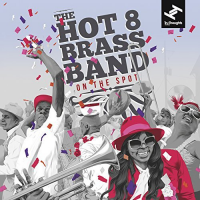 The Hot 8 Brass Band
The Hot 8 Brass BandOn the Spot
Tru-Thoughts Records
2017
On the Spot celebrates the fifth album and twenty year history of The Hot 8 Brass Band, the first American band signed by UK-based Tru-Thoughts Records. Like their New Orleans hometown, The Hot 8 knows tragedy, from Hurricane Katrina to the separate deaths of five bandmates, yet triumphantly and fiercely embody the Dionysian energy and gospel fervor in New Orleans' musical culture.
Certain music seems to come at you roaring and then detonate in between your ears with a sonic boom. On the Spot is just that type. There's no getting around it: The sound of "8 Kickin' It Live" is the sound of 'round-the-clock Mardi Gras, overflowing with vocal and instrumental calls and responses, merging the Dirty Dozen Brass Band and Go-Go funkateers Trouble Funk into a singular, unique sound, with the "If you want some, come get some" vocal inviting you to the party.
On the Spot launches several outside compositions into the Hot 8's unique musical orbit. It combines "Annie Mae" (Natalie Cole) with "Working Together" (Frankie Beverly) so seamlessly that they sound like a single Motown tune decked out for Mardi Gras. Their explosive banging of "That Girl" (Stevie Wonder) sounds so tightly arranged you wonder why nobody else did it this way (New Orleans style) before, and they expand Sade's slinky, quiet storm "Sweetest Taboo" into a stomping New Orleans twist and shout.
Yet they pull the worn and torn New Orleans blues standard "St. James Infirmary," a slow-rolling funeral procession full of hurt and heart, through an eight-minute moan led by trumpet which spans the emotional heights of heaven and depths of hell, and a roughhouse vocal that honors New Orleans' most famous and favorite son, Louis Armstrong.
Whether they're ripping through the US, the UK, elsewhere in Europe or across Australasia, The Hot 8 Brass Band simply doesn't stop. "We are privileged to tour and to tell the stories of life in our city, to keep alive the memories of our band members who have passed, as well as all the musicians who have gone before," explains band leader and tuba player Bennie Pete. "We can't wait to share this new music and party with our fans, who help us to keep pushing ourselves on."
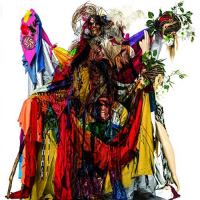 Nomade Orquestra
Nomade OrquestraEntremundos
Far Out Records
2017
Entremundos translates into "Between Worlds," and the second full-length offering from this remarkable ten-piece Brazilian orchestra is full of songs about motion and movement, written and performed in their São Paulo observatory. And while listening to the complete set takes you less than fifty minutes, the musical journey it takes you on is endless.
We begin in the "Jardins De Zaira," the "Gardens of Zaira" district of São Paulo where the Orquestra meets and rehearses. Simple, strummed acoustic the guitar opens the gate, and remains your lifeline through this river of melody in which flute, percussion, and horns swim and splash like colorful exotic fish. We traverse "Terra Fértil" ("Fertile Land") with wind instruments growling animal sounds while keyboard notes rain down like a cooling shower of electric rain, and percussion and drums rumble in accompanying thunder.
We more leisurely wind our way down the "Estrada Para Camomila" ("Road to Chamomile"), which weaves soul guitar, turntables and digital samples like a crown of wildflowers into its melody; the cool mid-song break, where the bass picks up its tempo from jazz walk to jazz stride just long enough for you to notice, feels like tripping through the Brazilian jungle with Henry Mancini and his horn section. This "Road" directly leads to "Felag Mengu" ("Migrant Farmers") marching out into the musical field to the beat of martial drums, crossing through a cool jazz intersection where a romantic Spanish dance floats upon piano and harmonizing brass.
"Rinoceronte Blues" stomps on a heavy-footed beat while harmonica and tenor sax jointly wail and growl the blues into a thoroughly beastly howl which circles back upon itself. "Vale De Boca Seca" sounds even more ferocious: The rhythm section, horn section and fuzz-toned lead guitar hook all seem to be playing in subtly different yet intersecting times, cooking up a scalding cauldron of Jeff Beck electric jazz-rock guitar fusion funked up by the Tower of Power horns.
Entremundos never once reaches beyond its grasp, and is even better than the Orchestra's eponymous debut, which was one of the best recordings I've ever heard. Even if they were to disband and stop right now, Nomade Orquestra would go down as one of the best progressive bands in Brazil's storied music history. But let's hope that this is just the beginning of what's becoming a remarkable story instead.
 The Sextones
The SextonesMoonlight Vision
Self-Produced
2017
Led by songwriter, singer and guitarist Mark Sexton, The Sextones retreated to the relative isolation of Prairie Sun Studios in Sonoma (one of Tom Waits' favorite recording locations) to lay down their full-length debut. "One of the intentions of Moonlight Vision's production was to have a sonically classic sounding album—sounds that are reminiscent of music we grew up listening to, but with a modern character," Sexton notes. "I think we achieved that."
Moonlight Vision captures the band's no-nonsense neo-soul sound in no-frills production, and overspills with the sound and feel of classic Motown, Stax, Hi and other legendary soul labels. (Its packaging lists the songs on "Side 1"and "Side 2," as if it was an old-school vinyl recording, too.) For example, I'd love to hear Al Green's wispy falsetto dance through "I Still Care," which sounds like Marvin Gaye and Maxwell swapping vocals along with several bottles of wine, and "How Could I Have Known."
Sexton floats up into his own falsetto in "Drunk Off Your Love," which spreads blue-eyed soul like thick and sticky Hall & Oates jam. The opening "Push On Through" does precisely that with a torrential flow of soul and R&B and rock straight from the band's collective heart, very much like a Stax Records shout by Sam and Dave except with only one singer (who also shreds some mean guitar rock in his bridge solo).
Punched up with horns in airtight arrangements, "Goodbye Yesterday" and "Blame It On My Youth," a hymn to the virtues of being young enough to get away with trouble, sound like Steely Dan working out a couple of R&B warhorses but without the bitter taste of Donald Fagen's cynicism.
Most of all, Moonlight Vision catches the sound of a young band still in search of itself but looking in some mighty promising directions. "Love, resentment, growing up, fear, stubborn defiance, and dissatisfaction with current times are reoccurring themes for Moonlight Vision," Sexton muses. Such themes won't be going away any time soon, and should give The Sextones plenty of material for wherever their follow-up may take them.
 The Three Sounds
The Three SoundsGroovin' Hard: Live at the Penthouse 1964-1968
Resonance Records
2016
In the five years spanning 1958 to '62, not only a time of great consolidation and experimentation in jazz but a glorious age for the label, who would you guess was Blue Note Records' best-selling act? Thanks to their nine albums and nearly two dozen more jukebox singles, it was The Three Sounds.
Led by pianist Gene Harris with constant bassist Andy Simpkins and a rotation of drummers, the Sounds helped solidify the acoustic piano trio as a vehicle for advanced jazz improvisation in the simplest but most profound manner possible: They played good, soulful music that people loved to hear. The rocking and rolling Groovin' Hard adds previously unreleased music from three different versions of the Sounds (swapping drummers Bill Dowdy for Carl Burnett for Kalil Madi) recorded during five years of engagements at Seattle's legendary local jazz treasure, The Penthouse, to their catalog.
"Gene came out of the church and he loved the blues. But he loved Erroll Garner and Oscar Peterson and mixed all of that up together," recalls pianist and Harris acolyte Monty Alexander in this set's notes. "His touch on the piano was crystal clear, immediately bringing up the feeling of blues as well as that cross between church and blues. He was greasy!" Harris sees himself much more simply: "I call myself a blues pianist with chops."
Groovin' Hard genuinely grooves hard. "Blue Genes" translates its boogie-woogie shuffle into an all-out sprint, with the rhythm section laying down the four/four and the piano leaping and dashing like an Olympic hurdler. Harris' original "Rat Down Front" has boogie form but rock 'n' roll delivery, like Art Tatum meeting Jerry Lee Lewis in a screaming caffeine rampage, and this set winds down with the first commercial release of the self-explanatory "The Boogaloo." If "The Boogaloo" doesn't get your head to bobbing or your toes to tapping, please make sure they're still attached.
Harris' touch with ballads and other gentle ruminations proves deft and distinguished. "The Shadow of Your Smile" faithfully renders Johnny Mandel's stylish sense of romance and grace, swinging on cymbals so soft and sure that it seems to shimmer. The open space in "The Night Has a Thousand Eyes" winks in the directions of Ahmad Jamal and Antonio Carlos Jobim's "One Note Samba" with funky elegance.
Groovin' Hard sounds and feels like a smooth glass of the finest brandy served neat, with each track its own small yet intoxicating sip. "The Three Sounds were my introduction to bluesy, funky style jazz and I have cherished them and collected their recordings ever since," explains Resonance Records founder George Klabin. Adding Groovin' Hard to their distinguished legacy must be so rewarding to him.
Tracks and Personnel:
Runnin' for the Ghost
Tracks: Return of the March; Seeing the Bigger Picture; Van Chatter; Runnin' for the Ghost; Hired Guns; Burning Van; Kang's Lament; Triple Bacon; The G; Sahara Cell Phones; Another Grain of Sand.
Personnel: Alicia Aubin: trombone; Ray McNamara: guitar; Tyler Burchfield: baritone sax, flute; Greg Blair: baritone sax; Andrew Klein: drums, cymbals, percussion; Lucas Ashby: congas, percussion, effects; Angelo Peters: bass, mini-moog, synthesizers; Dan Barker: guitar, baritone guitar; Dana Billings: Roland Juno, mini-moog, combination organs; Paulie Philippone: mini-moog, Wurlitzer electric piano; combination organs; Lex Schmidt: congas, percussion; Bobby Spellman: trumpet; Jamie Yaman: tenor saxophone; Josh Oxford: mini-moog, synthesizers; Jack Storer: trumpet.
All Smiles
Tracks: Let's Face the Music and Dance; I'm All Smiles; You Stepped Out of a Dream; I'm Glad There Is You; Get Out of Town; By Strauss; When Your Lover Has Gone; Gloria's Theme; Sweet & Lovely; High School Cadets.
Personnel: Benny Bailey: flugelhorn, trumpet; Francy Boland: keyboards, piano; Kenny Clarke: drums; Tony Coe: tenor sax; Jimmy Deuchar: trumpet; Sonny Grey: trumpet; Johnny Griffin: tenor sax; Derek Humble: alto sax; Nat Peck: trombone; Ake Persson: trombone; Dave Pike: vibes; Ronnie Scott: alto sax; Sahib Shihab: baritone sax, flute; Idrees Sulieman: trumpet; Erik Van Lier: trombone; Kenny Clare: drums; Jimmy Woode: bass.
On the Spot
Tracks: 8 Kickin' It Live; Get It How You Live; Bottom of the Bucket; On the Spot; St. James Infirmary; That Girl; Sweetest Taboo; Annie Mae; Working Together; Can't Nobody Get Down; Keepin' It Funky.
Personnel: Terrence Andrews: bass drum; Gregory Veals: trombone; Corey Peyton: trombone; Wendell Stewart: saxophone; Dr. Michael White: clarinet; Raymond Williams: trumpet; Gregory Veals: vocals; Michael Harvey: violin; Bennie Pete: sousaphone; Harry "Swamp Thang" Cook: bass drum; Raymond "Dr. Rackle" Williams: trumpet; Terrell "Burger" Batiste: trumpet; Alvarez "Big Al" Huntley: trumpet; Larry "Big World" Brown: trombone; Tyrus "Tito" Chapman: trombone; Dwayne "Douchie" Finnie: trombone; John "Prince" Gilbert: saxophone; Solomone Doyle: washboard; Sammy Cyrus: snare drum; Shawn King: snare drum; Philip Armand: snare drum; Errol Marchand: snare drum; Christopher Cotton: trumpet.
Entremundos
Tracks: Intro; Jardins De Zaira; Rinoceronte Blues; Terra Fértil; Estrada Para Camomila; Felag Mengu; Vale De Boca Seca; Madame Butterfly; Deliriuns; Olho Do Tempo; Travessia (Hidden Track).
Personnel: Guilherme Nakata: drums; Ruy Rascassi: bass; Fabio Prior: percussion; Luiz Eduardo Galvão: guitars; Marcos Mauricio: keyboards; Beto Malfatti: saxophones, flutes, pickups; Bio Bonato: baritone sax; Marco Stoppa: trumpet; André Calixto: tenor sax, soprano sax, flutes; Victor Fão: trombone; Beto Montag: vibes; Danilo Oliveira: VJ.
Moonlight Vision
Tracks: Push On Through; Drunk Off Your Love; How Could I Have Known; Analog Girl; Home Is You; Goodbye Yesterday; Blame It On My Youth; I Still Care; Can't Stop; Moonlight Vision; The End.
Personnel: Mark Sexton: vocals, guitar, Hammond B3, Mellotron; Alexander Korostinsky: electric bass, synthesizer bass, sitar; Daniel Weiss: drums, percussion; Ryan Taylor: Hammond B3, Wurlitzer, clavinet, grand piano, synthesizers; Eric Johnson: tenor sax; Ben Caiazza: trumpet, flugelhorn; Graham Marshall: violin; Jessica Vann: background vocals.
Groovin' Hard: Live at the Penthouse 1964-1968
Tracks: Girl Talk; The Night Has a Thousand Eyes; Blue Genes; The Shadow of Your Smile; Rat Down Front; Yours Is My Heart Alone; A.M. Blues; Bluesette; Caesar and Cleopatra; The Boogaloo.
Personnel: Carl Burnett: drums; Bill Dowdy: drums; Gene Harris: piano; Kalil Madi: drums; Andy Simpkins: bass.
< Previous
Remembering John Abercrombie
Next >
Five on Cellar Live
Comments
Tags
From the Inside Out
Chris M. Slawecki
Big Mean Sound Machine
Tony Allen
Andrew Klein
Dan Barker
Chemical Brothers
Kenny Clarke-Francy Boland Big Band
The Modern Jazz Quartet
Kenny Clare
duke ellington
Count Basie
Thelonious Monk
Benny Bailey
Chet Baker
Ronnie Scott
Bill Evans
Vince Guaraldi
The Hot 8 Brass Band
Dirty Dozen Brass Band
Trouble Funk
Natalie Cole
Frankie Beverly
Stevie Wonder
Sade
Louis Armstrong
Bennie Pete
Nomade Orquestra
Henry Mancini
jeff beck
Tower of Power
The Sextones
Mark Sexton
Tom Waits
Al Green
Marvin Gaye
Maxwell
Hall & Oates
Sam and Dave
steely dan
Donald Fagen
The Three Sounds
Gene Harris
Andy Simpkins
Bill Dowdy
Carl Burnett
Kalil Madi
Erroll Garner
oscar peterson
Monty Alexander
Art Tatum
Jerry Lee Lewis
Johnny Mandel
Ahmad Jamal
Antonio Carlos Jobim
For the Love of Jazz
 All About Jazz has been a pillar of jazz since 1995, championing it as an art form and, more importantly, supporting the musicians who create it. Our enduring commitment has made "AAJ" one of the most culturally important websites of its kind, read by hundreds of thousands of fans, musicians and industry figures every month.
All About Jazz has been a pillar of jazz since 1995, championing it as an art form and, more importantly, supporting the musicians who create it. Our enduring commitment has made "AAJ" one of the most culturally important websites of its kind, read by hundreds of thousands of fans, musicians and industry figures every month.






